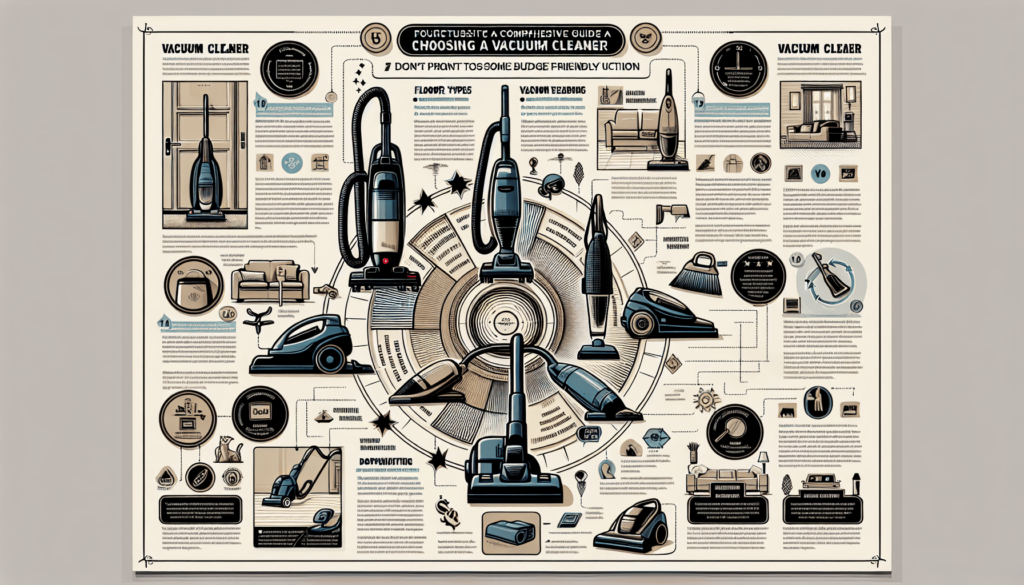Choosing the right vacuum for your home can be a daunting task, but fear not, because we’ve got you covered! In this ultimate guide, we will help you navigate through the overwhelming sea of options and find the perfect vacuum specifically tailored to meet your cleaning needs. From the powerful and reliable Home Depot models to the innovative technology of Dyson vacuums, we will explore the features, benefits, and everything else you need to know to make an informed decision. So get ready to say goodbye to the dust bunnies and hello to a cleaner, healthier home!
Consider the Type of Vacuum
When it comes to choosing a vacuum for your home, the first step is to consider the type of vacuum that will best fit your needs. There are several options available, each with its own advantages and disadvantages.
Upright Vacuums
Upright vacuums are the most traditional and popular choice for many households. They feature a design where the cleaning head is attached directly to the body of the vacuum, making them easy to push and maneuver across carpets and large areas. Upright vacuums are typically equipped with powerful suction, making them great for deep cleaning and removing pet hair. However, they can be bulky and heavy, making them less ideal for stairs and tight spaces.
Canister Vacuums
Canister vacuums consist of a main body unit connected to a separate cleaning head by a hose. This design provides flexibility and maneuverability, allowing you to clean both large areas and hard-to-reach spaces. Canister vacuums are especially suitable for homes with a combination of carpeted and hard floor surfaces. They are generally lighter and easier to carry and store than upright vacuums. However, the separate components may require additional effort when vacuuming large areas.
Stick Vacuums
Stick vacuums are lightweight and slim, resembling a broom with a suction head at the bottom. They are perfect for quick clean-ups and smaller spaces such as apartments or kitchens. Stick vacuums are convenient to store due to their compact size and are often cordless, allowing for freedom of movement. However, their smaller size may result in less suction power and smaller dust canister capacity.
Handheld Vacuums
Handheld vacuums are small, portable devices that are great for spot-cleaning and handling small messes. They are ideal for cleaning vehicles, upholstery, stairs, and hard-to-reach corners. Handheld vacuums are lightweight and easy to carry, making them a convenient option for quick clean-ups. However, they may not have the same suction power as larger vacuums and may require more frequent emptying of the dust canister.
Robot Vacuums
Robot vacuums have gained popularity in recent years for their autonomous cleaning capabilities. These small, disc-shaped devices move around your home, using sensors to detect and navigate obstacles while vacuuming. Robot vacuums are perfect for individuals with a busy lifestyle or limited mobility, as they can be programmed to clean on a schedule and reach under furniture. However, they may not provide the same deep cleaning as manual vacuums and may require additional maintenance.
Evaluate Your Cleaning Needs
Once you have considered the type of vacuum that suits your preferences, it’s important to evaluate your specific cleaning needs. Understanding your requirements will help you choose a vacuum that can handle your home’s unique challenges.
Floor Type
Consider the types of flooring in your home. If you have mostly carpeted areas, you’ll want to prioritize a vacuum with strong suction power and a brush roll designed to agitate and lift dirt from carpets. For homes with mostly hard floors, such as hardwood or tile, look for a vacuum with adjustable settings to prevent scratches and a cleaning head that effectively picks up dust and debris.
Pet Hair
If you have pets, choosing a vacuum specifically designed for pet hair is essential. Look for models with specialized attachments and brush rolls that can easily remove pet hair from furniture, carpets, and other surfaces. Vacuums with strong suction and HEPA filtration can help to capture allergens and dander that may be present in pet hair.
Allergies
If you or your family members suffer from allergies, it’s imperative to choose a vacuum with a HEPA filtration system. HEPA filters are designed to capture small particles, including allergens like dust mites, pollen, and pet dander. This will help to improve the air quality in your home and reduce allergy symptoms.
Stairs
Consider the layout of your home and whether you have a significant number of stairs. Upright vacuums can be heavy and difficult to maneuver on stairs, whereas canister or stick vacuums may be more suitable. Handheld vacuums are also a great option for tackling stairs due to their compact size and portability.
Carpeted Areas
If you have a lot of carpeted areas in your home, pay attention to the vacuum’s brush roll and suction power. Look for models with adjustable height options to accommodate different carpet lengths and densities. Additionally, models with rotating or powered brush rolls can provide a more thorough clean.
Hard Floors
For homes with primarily hard floors, consider vacuums that have specific attachments or features designed for these surfaces. Features like a microfiber or soft brush attachment can help to prevent scratches and effectively pick up debris from hard floors without scattering it around.

Check the Suction Power and Filtration System
The suction power and filtration system of a vacuum are crucial factors to consider to ensure it meets your cleaning needs effectively and efficiently.
Suction Power
The suction power of a vacuum determines how well it can pick up dirt, dust, and debris from your floors. Look for models that advertise strong suction power, typically measured in watts or air watts. Higher suction power generally translates to better cleaning performance, particularly on carpets and rugs. Keep in mind that the type of vacuum and its additional features, such as brush rolls, can also impact its overall cleaning effectiveness.
HEPA Filtration
HEPA stands for High-Efficiency Particulate Air, and vacuums with HEPA filters are highly effective in trapping small particles and allergens. If you or your family members have allergies or asthma, investing in a vacuum with a HEPA filtration system is essential. These filters capture particles as small as 0.3 microns, ensuring cleaner air quality in your home. HEPA filters are particularly beneficial for allergies caused by dust mites, pollen, and pet dander.
Bagged vs Bagless
When considering the filtration system, also weigh the pros and cons of bagged and bagless vacuums. Bagged vacuums use disposable bags to capture dirt and debris, which can be easier to dispose of and often result in less contact with allergens. On the other hand, bagless vacuums use dust canisters that require regular emptying. While bagless vacuums can be more cost-effective in the long run, they may expose you to more allergens during emptying.
Consider the Size and Weight
The size and weight of a vacuum can greatly impact its usability and convenience. It’s important to evaluate these factors to ensure that the vacuum you choose is easy to maneuver and store.
Maneuverability
Consider how easily the vacuum will move around your home. Upright vacuums, while powerful, can be heavy and may require more effort to push and maneuver. Canister vacuums are typically lighter and more versatile due to their separate cleaning head, making them easier to maneuver and use in tight spaces. Stick and handheld vacuums are lightweight and designed for ease of use, particularly in small areas or to handle quick clean-ups.
Storage Space
Take into account the available storage space in your home. Upright vacuums can be bulkier and may require a dedicated storage closet or space. Canister vacuums are more compact and may have a smaller footprint, making them ideal for smaller storage spaces. Stick and handheld vacuums are generally slim and can be easily stored in a closet or mounted on a wall. Robot vacuums are self-contained and usually come with charging stations, requiring minimal storage space.

Look for Additional Features
In addition to the basic functionalities, there are several additional features and considerations that can enhance your vacuuming experience.
Attachments and Accessories
Consider the attachments and accessories that come with the vacuum. Attachments such as crevice tools, upholstery brushes, and dusting brushes can add versatility to your cleaning routine. Make sure the vacuum you choose offers the attachments you need to clean various surfaces and hard-to-reach areas.
Cord Length and Retractable Cord
For corded vacuums, check the length of the power cord. A longer cord can provide greater reach without needing to switch outlets frequently. Additionally, models with a retractable cord feature make storage more convenient and prevent tangling.
Battery Life and Charging Time
If you’re considering a cordless vacuum, battery life is an important consideration. Look for models that offer sufficient battery life to clean your entire home without needing to recharge. Additionally, consider the charging time required to replenish the battery so that it does not disrupt your cleaning routine.
Noise Level
Take into account the noise level of the vacuum, particularly if you have young children, pets, or live in an apartment building. Many manufacturers now offer quieter models that still provide powerful cleaning performance while minimizing noise disruption.
Indicator Lights
Some vacuum models have indicator lights or alerts to notify you when the dust canister is full or the filter needs cleaning or replacement. These features can help you maintain the vacuum’s performance and prolong its lifespan.
Adjustable Height
Consider if the vacuum has adjustable height settings. This feature is particularly useful when transitioning between different floor types or adapting to varying carpet thicknesses. Adjustable height settings ensure optimal cleaning results and prevent damage to delicate carpets or hard floors.
Clear Dust Canister
Opting for a vacuum with a clear dust canister allows you to easily see when the canister needs emptying, preventing any decline in suction power or performance.
Automatic Allergen Sealing
Some vacuum models offer automatic allergen sealing capabilities, ensuring that the dust and allergens captured during cleaning stay securely sealed within the vacuum’s filtration system. This feature can be especially beneficial for individuals with allergies or asthma, as it reduces the risk of exposure to allergens during emptying and maintenance.
Research on Brand and Product Reputation
Before settling on a specific vacuum model, it’s essential to conduct research on both the brand and product reputation to ensure you make a reliable and durable investment.
Reliability
Look for brands with a history of producing reliable and high-quality vacuum cleaners. Online resources, customer reviews, and testimonials can provide valuable insights into the reliability of different brands and models.
Durability
Consider the durability of the vacuum and how well it withstands regular use. Brands known for using durable materials and manufacturing techniques are more likely to provide longer-lasting products. Again, customer reviews and product testing websites can provide valuable information on the durability of various vacuums.
Customer Reviews
Taking the time to read customer reviews can help you gain insights into the real-life experiences of other users. Look for recurring positive comments or concerns that could impact your decision. These reviews can help you gauge the overall satisfaction level of customers and identify any potential issues or limitations of the vacuum you’re considering.
Set Your Budget
Determining your budget before purchasing a vacuum is essential to ensure you find the right balance between affordability and desired features. Vacuums can range in price from budget-friendly options to high-end models.
Determine a Range
Consider the amount you are comfortable spending on a vacuum cleaner. By setting a budget range, you can narrow down your options and focus on models within your preferred price range. Be realistic about your expectations, as more advanced features and higher performance may come with a higher price tag.
Consider Long-term Investment
While it’s tempting to opt for the least expensive vacuum available, it’s important to balance the initial cost with the long-term investment. Cheaper models may require more frequent repairs, have shorter lifespans, or lack the performance and features necessary for your cleaning needs. Investing in a higher-quality vacuum may save you money in the long run by providing better cleaning results and durability.
Compare Prices and Warranty
Once you have identified the vacuums that align with your preferences, comparing prices and warranty options will help you make an informed decision.
Price Range
Compare prices for the vacuum models you are interested in to ensure they fall within your determined budget range. Keep in mind that prices may vary across different retailers, so it’s worth checking for discounts, promotions, or package deals before making a purchase.
Manufacturer Warranty
Review the warranty provided by the manufacturer. A longer warranty period can provide peace of mind, knowing that you are protected against any potential defects or repairs. Pay attention to the specific terms and conditions of the warranty, including any limitations or requirements.
Extended Warranty
Consider whether an extended warranty is worth the additional cost. Extended warranties can offer extra protection beyond the manufacturer’s warranty, covering repairs and potential issues that may arise in the future. Evaluate the cost of the extended warranty versus the expected lifespan of the vacuum and your own personal maintenance habits.
Read Expert and Consumer Reviews
Consulting both expert and consumer reviews can provide valuable insights into the performance, durability, and overall satisfaction of different vacuum models.
Product Testing Websites
Visit reputable product testing websites that provide unbiased and in-depth reviews of various vacuum models. These websites often conduct rigorous tests, evaluating performance, durability, and other key features. Expert reviews can give you a well-rounded understanding of the pros and cons of different vacuums.
Online Retailers
Many online retailers allow customers to leave reviews and ratings for products they have purchased. These reviews can provide real-life experiences and offer insights into the long-term performance, durability, and customer satisfaction of specific vacuum models.
Consumer Reviews
In addition to expert reviews, reading customer reviews on reputable websites can help you gauge the overall satisfaction of buyers. Pay attention to recurring themes or concerns mentioned in these reviews to ensure they align with your specific needs and expectations.
Test and Try Before Purchase
Finally, if possible, try out the vacuum before making a final decision. This can be done through in-store demonstrations, rentals, or taking advantage of trial periods offered by manufacturers or retailers.
In-store Demonstrations
If you have the opportunity, visit a retail store where you can see and possibly test various vacuum models. In-store demonstrations allow you to assess the weight, maneuverability, and overall feel of the vacuum. It also provides a chance to ask questions and gain insights from knowledgeable sales representatives.
Rentals
Consider renting a vacuum before committing to a purchase. This allows you to experience the vacuum firsthand and test its performance in your own home. Renting can help you determine if the vacuum meets your specific cleaning needs and if it’s worth investing in for the long term.
Trial Period
Some manufacturers or retailers offer trial periods, allowing you to purchase a vacuum and try it in your home for a specified period. If you’re not satisfied with the performance or features during the trial period, you can return it for a refund or exchange. This can be an excellent opportunity to put the vacuum to the test and ensure it’s the right fit for your cleaning needs.
By considering the type of vacuum, evaluating your cleaning needs, checking the suction power and filtration system, considering the size and weight, looking for additional features, researching brand and product reputation, setting your budget, comparing prices and warranty, reading expert and consumer reviews, and testing and trying before purchase, you can make a well-informed decision when choosing a vacuum for your home. Remember to prioritize your specific requirements and preferences to find a vacuum that will make your cleaning routine more effective and efficient.


